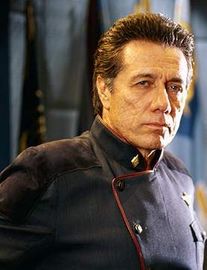In this author’s opinion, continuity is the glue that holds a sci-fi universe or series together. When I speak of ‘continuity’ in this sense, I’m not talking about whether an actor looks the same from one shot to another, or that the level of someone’s drink doesn’t fluctuate between scenes. No, I’m talking about a storyline that keeps itself internally consistent. I’m a super stickler for that kind of thing. Why?
Science fiction already requires some help to suspend the reader or viewer’s disbelief. We’ve got aliens, flying cars, faster-than-light travel and all that good stuff we don’t have running around in real life. When the boundaries of that continuity are smooth and seamless, it makes it a heck of a lot easier to swallow the concept of Klingons, lightsabers and giant robots.

This is one of the largest cranes in the world.
Sometimes even this isn’t enough to suspend my disbelief.
But when the continuity is sloppy or inconsistent, when the established rules of that universe are lazily ignored, the cracks show through in a hurry. It reminds us that we’re not peering off into some other distant time and place, but rather that we’re looking at a bunch of actors standing around on a set made of plastic and wood. Sci-fi movies, novels, TV shows, and comic books all desperately need a solid continuity just as a given. It’s the foundation on which the story is built. Build a house on a faulty foundation, and well, you get the idea.
So, here are three examples from sci-fi where the continuity frayed with varying degrees of consequences. Here we go…
Terminator 2: Judgment Day
First off, I love this movie. James Cameron is my favorite action director, hands down, and I think this movie is some of his finest work. His stories tend to be pretty well thought out, which is why this continuity slip irks me. In the first Terminator movie, Kyle Reese tells Sarah Connor that time travel is only possible due to ‘a field generated by a living organism.’ This explains why Kyle arrives in 1984 wearing only his birthday suit with no futuristic equipment like plasma pulse-rifles, etc. The Terminator itself is a machine, but its endoskeleton is covered with actual living tissue, so that explains that, right?
In T2, however, the T-1000 comes through just fine. Even though it appears to be a man (and still arrives naked), its entire body is actually made of a liquid metal (a mimetic polyalloy if you want to get technical). There’s nothing organic about it, at least nothing that’s ever revealed to the audience. So, how exactly did it travel through time?
Granted, we get all of our information about time travel from Kyle, who admits he doesn’t ‘know tech stuff,’ but it still causes a wrinkle. Even if it doesn’t destroy the movie for me (and it doesn’t), it still reminds me that someone wasn’t paying attention to their own canon.
Battlestar Galactica “Hero”
This episode of the reimagined Galactica series is from the notoriously wobbly Season 3. I’m not sure what happened to this show. It went from being some of the best sci-fi I have ever seen on television to a show that was almost painful to watch near the end. Season 3 was really where the continuity of the show wore thin, and this episode pretty much sums it up for me.
If you haven’t seen it, let me explain: So, Admiral Adama (Edward James Olmos) is being awarded a medal for his years of meritorious military service. Adama, however, harbors a secret that’s been tearing him up inside. We get a flashback to when he commanded the Battlestar Valkyrie a year before the 13 Colonies of Cobol were destroyed. It turns out that he may have been the one who inadvertently touched off the war with the Cylons (or so he suspects), which resulted in billions of deaths. So, being awarded a medal for heroism cuts him like a knife. It is full of angst and regret, moving background music, and it’s exquisitely acted by a veteran cast.
So what’s the problem? Well, it had been established previously that Adama had been in command of the Galactica for several years leading up to the outbreak of war. So how could he have been on the mission with the Valkyrie, when he was already firmly stationed on Galactica? Whoops! Someone needed to keep track of their timeline a little better, huh? It undermined the entire episode, and quite frankly, the show would have been better off as a whole if it had been left out.
Star Trek: Enterprise
My first example was pretty minor. My second was pretty bad…but the last is one of the worst offenders I can think of – Star Trek: Enterprise. Not just one episode, nor even one season, but the entire series from start to finish. It’s one of the most glaring continuity errors in science fiction history. Why is that?
The series takes place in the timeline well before Kirk and Spock, serving as a prequel to the other Star Treks. The Enterprise in this Star Trek series is touted as the first human-manned ship to leave our solar system. In fact, that’s a major part of the show’s pilot episode. For her time, she’s supposed to be the most advanced starship ever built by human hands, and is supposed to have started the legend that later starships named Enterprise would build upon. James T. Kirk, John Harriman, Rachel Garrett and Jean-Luc Picard all stand upon its shoulders, right?
So why is there no mention of it before this series? Wouldn’t a ship occupying that singular place in human history be mentioned before that somewhere? Well, in the conference room aboard Picard’s Enterprise-D, you can see the outlines of past ships bearing that name. There’s a string of ships from the aircraft carrier, to Kirk’s original ship, then the A, the B, and up through D.
So where is the Enterprise-NX in all of that? It’s suspiciously absent from the lineup. That’s because the showrunners made her up on the spot without much consideration for what history had already been established for the show. They could have chosen any other name for the ship and been okay. The Valiant, the Constellation, the Good Ship Lollipop, S.S. Minnow – anything, and it would have worked out just fine. But no, they just had to go and name her Enterprise, didn’t they?
And this show ran for 5 seasons.
Yeah, that was pretty much what I thought, too.
So, is all of this needless nitpicking by a fan who should really find something else to do with his time? Probably. I’ll admit that I speculate and ponder things like this quite a bit, and when there’s a mistake, I generally find it.
It’s not for the purpose of harping on it, to point fingers at the creators/authors and say, “Ha Ha!” like Nelson from the Simpsons. No, it’s because when I want to immerse myself in sci-fi, I want to believe on some level that what I’m reading or seeing could exist out there somewhere in the past, present or future, and share in that discovery or adventure. A consistent continuity allows me to do that; a faulty one reminds me that I’m just some poor schlub with a Netflix account.















